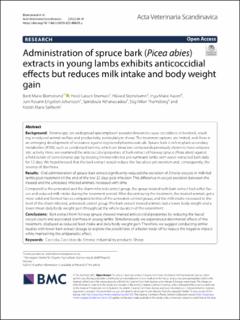| dc.contributor.author | Blomstrand, Berit Marie | |
| dc.contributor.author | Enemark, Heidi L | |
| dc.contributor.author | Steinshamn, Håvard | |
| dc.contributor.author | Aasen, Inga Marie | |
| dc.contributor.author | Johanssen, Juni Rosann E. | |
| dc.contributor.author | Athanasiadou, Spiridoula | |
| dc.contributor.author | Thamsborg, Stig Milan | |
| dc.contributor.author | Sørheim, Kristin | |
| dc.date.accessioned | 2022-08-05T09:25:05Z | |
| dc.date.available | 2022-08-05T09:25:05Z | |
| dc.date.created | 2022-04-25T19:58:00Z | |
| dc.date.issued | 2022 | |
| dc.identifier.citation | Acta Veterinaria Scandinavica (AVS). 2022, 64, 1-10. | en_US |
| dc.identifier.issn | 0044-605X | |
| dc.identifier.uri | https://hdl.handle.net/11250/3010304 | |
| dc.description.abstract | Background Eimeria spp. are widespread apicomplexan parasites known to cause coccidiosis in livestock, resulting in reduced animal welfare and productivity, particularly in sheep. The treatment options are limited, and there is an emerging development of resistance against registered pharmaceuticals. Spruce bark is rich in plant secondary metabolites (PSM), such as condensed tannins, which are bioactive compounds previously shown to have antiparasitic activity. Here, we examined the anticoccidial properties of bark extract of Norway spruce (Picea abies) against a field isolate of ovine Eimeria spp. by treating Eimeria-infected pre-ruminant lambs with water-extracted bark daily for 12 days. We hypothesised that the bark extract would reduce the faecal oocyst excretion and, consequently, the severity of diarrhoea. Results Oral administration of spruce bark extract significantly reduced the excretion of Eimeria oocysts in milk-fed lambs post treatment till the end of the trial 22 days post infection. This difference in oocyst excretion between the treated and the untreated infected animals increased with time. Compared to the untreated and the sham-infected control group, the group treated with bark extract had softer faeces and reduced milk intake during the treatment period. After discontinuing the treatment, the treated animals got a more solid and formed faeces compared to that of the untreated control group, and the milk intake increased to the level of the sham-infected, untreated control group. The bark extract treated animals had a lower body weight and a lower mean daily body weight gain throughout the whole duration of the experiment. Conclusions Bark extract from Norway spruce showed marked anticoccidial properties by reducing the faecal oocyst count and associated diarrhoea in young lambs. Simultaneously we experienced detrimental effects of the treatment, displayed as reduced feed intake and daily body weight gain. Therefore, we suggest conducting similar studies with lower bark extract dosage to explore the possibilities of a better trade-off to reduce the negative impact while maintaining the antiparasitic effect. Keywords: Coccidia, Coccidiocide, Eimeria, Industrial by-products, Sheep | en_US |
| dc.language.iso | eng | en_US |
| dc.publisher | Biomed Central | en_US |
| dc.rights | Navngivelse 4.0 Internasjonal | * |
| dc.rights.uri | http://creativecommons.org/licenses/by/4.0/deed.no | * |
| dc.subject | Sheep | en_US |
| dc.subject | Industrial by-products | en_US |
| dc.subject | Eimeria | en_US |
| dc.subject | Coccidiocide | en_US |
| dc.subject | Coccidia | en_US |
| dc.title | Administration of spruce bark (Picea abies) extracts in young lambs exhibits anticoccidial efects but reduces milk intake and body weight gain | en_US |
| dc.title.alternative | Administration of spruce bark (Picea abies) extracts in young lambs exhibits anticoccidial efects but reduces milk intake and body weight gain | en_US |
| dc.type | Peer reviewed | en_US |
| dc.type | Journal article | en_US |
| dc.description.version | publishedVersion | en_US |
| dc.rights.holder | © The Author(s) 2022. Open Access This article is licensed under a Creative Commons Attribution 4.0 International License, which permits use, sharing, adaptation, distribution and reproduction in any medium or format, as long as you give appropriate credit to the original author(s) and the source, provide a link to the Creative Commons licence, and indicate if changes were made. The images or other third party material in this article are included in the article’s Creative Commons licence, unless indicated otherwise in a credit line to the material. If material is not included in the article’s Creative Commons licence and your intended use is not permitted by statutory regulation or exceeds the permitted use, you will need to obtain permission directly from the copyright holder. To view a copy of this licence, visit http://creativecommons.org/licenses/by/4.0/. The Creative Commons Public Domain Dedication waiver (http://creativeco mmons.org/publicdomain/zero/1.0/) applies to the data made available in this article, unless otherwise stated in a credit line to the data. | en_US |
| dc.source.pagenumber | 10 | en_US |
| dc.source.volume | 64 | en_US |
| dc.source.journal | Acta Veterinaria Scandinavica (AVS) | en_US |
| dc.identifier.doi | 10.1186/s13028-022-00629-y | |
| dc.identifier.cristin | 2019035 | |
| dc.relation.project | EC/H2020/774340 | en_US |
| dc.relation.project | Norges forskningsråd: 268264 | en_US |
| dc.relation.project | Regionalt forskningsfond Møre og Romsdal: 282467 | en_US |
| dc.source.articlenumber | 10 | en_US |
| cristin.ispublished | true | |
| cristin.fulltext | original | |
| cristin.qualitycode | 1 | |

